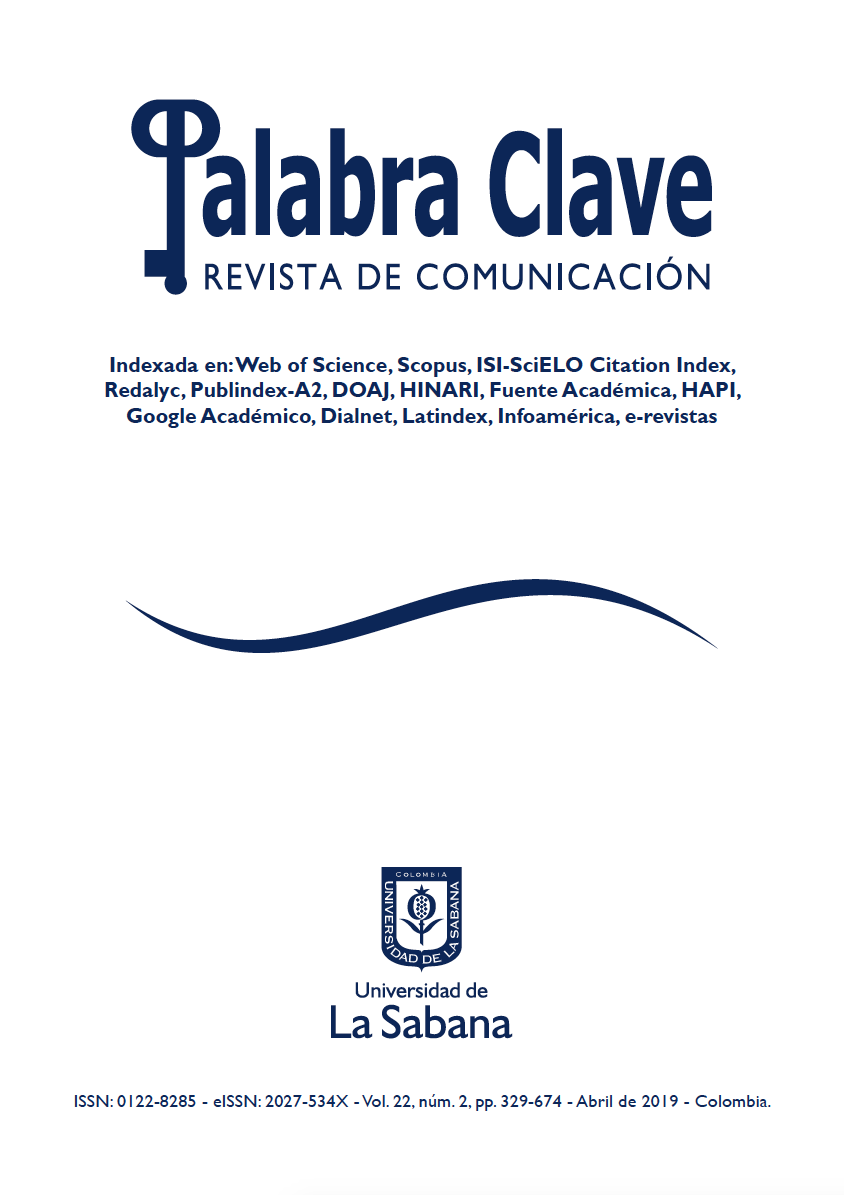El cine como espejo diferido: el concepto de transferencia en André Bazin y Stanley Cavell
DOI:
https://doi.org/10.5294/pacla.2019.22.3.4Keywords:
Cinema, realism, theory, photography, transference, André Bazin, Stanley CavellAbstract
Cinema as a Delayed Mirror: The Concept of Transfer in André Bazin and Stanley Cavell
O cinema como espelho diferido: o conceito de transferência em André Bazin e Stanley Cavell
This article revives André Bazin’s vision to suggest its relevance at the time of dealing with the ever-changing nature of cinema, specifically with new cinematographic forms. Bazin’s theory is based —in an apparently paradoxical way— on the identity between the actual model and its photographic image, a complex premise that would be elaborated decades later by the American philosopher Stanley Cavell. This paper states first the meaning of this identity. In order to delimit the scope and repercussions of this ontological identity in the perception of a cinematographic image, the concept is approached in relation to those of similarity and causality. Then, its scope is explained from the concept of transfer. To arrive at a thorough understanding of this process, the way in which it is expressed in both theorists’ works is analyzed. One of the main conclusions is that realism is not something to be conferred by the subject on the photographic image, but its property by virtue of the transfer of reality from the object to the image. This shows how the film viewer, in front of the screen, carries out a process analogous to that of everyday perception: recognizing a reality depicted on the screen.
Para citar este artículo / to reference this article / para citar este artigo
Esqueda-Verano, L. (2019). El cine como espejo diferido: el concepto de transferencia en André Bazin y Stanley Cavell. Palabra Clave, 22(3), e2234. DOI: https://doi.org/10.5294/pacla.2019.22.3.4
Recibido: 01/03/2018
Aceptado: 11/10/2018
Downloads
References
Andrew, D. (1993). Las principales teorías cinematográficas. Madrid, España: Rialp.
Andrew, D. (2010). What cinema is! Bazin’s quest and its charge. Hoboken, EE. UU.: Wiley-Blackwell.
Andrew, D. (2013). André Bazin. Nueva York, EE. UU.: Oxford University Press.
Andrew, D. & Joubert-Laurencin, H. (Eds.) (2011). Opening Bazin: Postwar film theory and its afterlife. Nueva York, EE. UU.: Oxford University Press.
Baudrillard, J. (1984). Cultura y simulacro. Barcelona, España: Kairós.
Bazin, A. (1945). Ontologie de l’image photographique. Confluences, 1, 405-411. Recuperado de https://bazin.yale.edu/ontologie-de-limage-photographique
Bazin, A. (1947). Farrebique ou le paradoxe du réalisme. Esprit, 132, 676-680. Recuperado de https://esprit.presse.fr/article/andre-bazin/farrebique-ou-le-paradoxe-du-realisme-21826
Bazin, A. (1953). Le langage de notre temps. En Autor, Regards neufs sur le cinéma (pp. 14-16). París, Francia: Le Seuil.
Bazin, A. (1957). Mort d’Humphrey Bogart. Cahiers du Cinéma, (68), 2-8.
Bazin, A. (1958). Qu’est-ce que le cinéma? París, Francia: Éditions du Cerf.
Bazin, A. (1966). ¿Qué es el cine? Madrid, España: Rialp.
Bazin, A. (2014). Andre Bazin’s new media. Oakland, EE. UU.: University of California Press.
Bertoncini, M. (2009). Teorie del realismo di André Bazin. Milán, Italia: LED-Edizioni Universitarie de Lettere Economia Diritto.
Borges, J. L. (1992). Obras completas. Barcelona, España: Círculo de Lectores.
Brubaker, D. (1993). Andre Bazin on automatically made images. Journal of Aesthetics and Art Criticism, 51(1), 59-67. DOI: 10.2307/431971
Carroll, N. (1988). Philosophical problems of classical film theory. Princeton, EE. UU.: Princeton University Press.
Cavell, S. (1979). The world viewed: Reflections on the ontology of film. Cambridge, EE. UU.: Harvard University Press.
Cavell, S. (2005). Cavell on film. Albany, EE. UU.: State University of New York Press.
Dubois, P. (1986). El acto fotográfico: de la representación a la recepción. Barcelona, España: Paidós.
During, L. & Trahair, L. (2012). Belief in cinema. Angelaki, 17(4), 1-8. 10.1080/0969725X.2012.747326
Esqueda-Verano, L. (2018). La ontología de la imagen híbrida: actualización de las premisas ontológicas en la teoría de André Bazin. Fotocinema: Revista cinetífica de cine y fotografía, 16, 243-264. Recuperado de: http://www.revistas.uma.es/index.php/fotocinema/article/view/4095/3812
Friday, J. (2005). André Bazin’s ontology of photographic and film imagery. The Journal of Aesthetics and Art Criticism, 63(4), 339-350. Recuperado de https://www.jstor.org/stable/3700510
Husserl, E. (2002). Lecciones de fenomenología de la conciencia interna del tiempo. Madrid, España: Trotta.
Husserl, E. (2006). Meditaciones cartesianas. Madrid, España: Tecnos.
Lebedev, O. (2016). La robe sans couture de la réalité: André Bazin et l’apologie du réalisme cinématographique. Bulletin d’analyse phénoménologique, 12(4), 189-209. https://popups.uliege.be:443/1782-2041/index.php?id=870
Morgan, D. (2006). Rethinking Bazin: Ontology and realist aesthetics. Critical Inquiry, 32(3), 443-481. 10.1086/505375
Morgan, D. (2015). Stanley Cavell: The contingencies of film and its theory. En M. Pomerance & R. B. Palmer (Eds.), Thinking in the dark: Cinema, theory, practice (pp. 162-173). New Brunswick, EE. UU.: Rutgers University Press.
Percy, W. (1998). The Moviegoer. Nueva York: Vintage Books.
Rosen, P. (2001). Change mummified: Cinema, historicity, theory. Minneapolis, EE. UU.: University of Minnesota Press.
Rothman, W. (2007). Bazin as a Cavellian realist. Film International, 5(6), 54-61. DOI : 10.1386/fiin.5.6.54
Rouquier, G. (1946). Farrebique ou Les quatre saisons [Documental]. Les Films Etienne Lallier.
Sartre, J.-P. (1940). L’imaginaire : psychologie phénoménologique de l’imagination. París, Francia: Gallimard.
Smith, D. (2013). Introduction: Revisiting André Bazin. Paragraph, 36(1), 1-9. 10.3366/para.2013.0074
Totaro, D. & Younger, P. (2003). Focus on Bazin. Off Screen, 7. Recuperado de https://offscreen.com/issues/view/vol7_7
Ungaro, J. (2000). André Bazin: généalogies d’une théorie. París, Francia: L’Harmattan.
VV. AA. (2007). Feature Bazin. Film International, 5.
Walton, K. L. (2008). Marvelous images: On values and the arts. Nueva York, EE. UU.: Oxford University Press.
Wollen, P. (1972). Signs and meaning in the cinema. Blomington, EE. UU.: Indiana University Press.
Published
How to Cite
Issue
Section
License
1. Proposed Policy for Journals That Offer Open Access
Authors who publish with this journal agree to the following terms:
- Authors retain copyright and grant the journal right of first publication with the work simultaneously licensed under a Creative Commons Attribution License that allows others to share the work with an acknowledgement of the work's authorship and initial publication in this journal.








